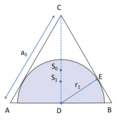File:FS EH dia.png
FS_EH_dia.png (559 × 574 pixels, file size: 24 KB, MIME type: image/png)
Captions
Captions
Summary[edit]
| DescriptionFS EH dia.png |
English: Largest semicircle in an equilateral triangle
Deutsch: Größter Halbkreis in einem gleichseitigen Dreieck |
| Date | |
| Source | Own work |
| Author | Hans G. Oberlack |

The equilateral triangle as base element. Inscribed is the largest semicircle.
General case[edit]
Segments in the general case[edit]
0) The side length of the equilateral base triangle is:
1) The radius of the semicircle is: 
Perimeters in the general case[edit]
0) Perimeter of equilateral base triangle: 
1) Perimeter of inscribed semicircle: 
Areas in the general case[edit]
0) Area of the equilateral base triangle: 
1) Area of the inscribed semicircle:
Centroids in the general case[edit]
0) By definition the centroid point of a base shape is
1) The centroid point of the inscribed semicircle relative to the centroid of the base shape is: 

Normalised case[edit]
In the normalised case the area of the base shape is set to 1.
So
Segments in the normalised case[edit]
0) Side length of the triangle
1) The radius of the semicircle is: 
Perimeters in the normalised case[edit]
0) Perimeter of base triangle: 
1) Perimeter of inscribed semicircle: 
S) Sum of perimeters:
Areas in the normalised case[edit]
0) Area of the base triangle is by definition
1) Area of the inscribed semicircle:
Centroids in the normalised case[edit]
By definition the centroid point of a base shape is
The positon of point D relative to 
1) The centroid point of the inscribed semicircle relative to the centroid of the base shape is:
Distances of centroids[edit]
The distance between the centroid of the base triangle and the centroid of the semicircle is:
Sum of distances:
Identifying number[edit]
Apart of the base element there is one other shape allocated. Therefore the integer part of the identifying number is 1.
The decimal part of the identifying number is the decimal part of the sum of the perimeters and the distances of the centroids in the normalised case.
So the identifying number is: 
Calculations[edit]
Known elements[edit]
(0) Given is the side length of the equilateral triangle:
(1)
(2)
(3)
(4)
(5)
(6)
(7)
(8)
(9)
Calculation 1[edit]
The height 






Calculation 2[edit]


Calculation 3[edit]
First the similarity of 








so 

The similarity means:
















Calculation 4[edit]







-->
Licensing[edit]
- You are free:
- to share – to copy, distribute and transmit the work
- to remix – to adapt the work
- Under the following conditions:
- attribution – You must give appropriate credit, provide a link to the license, and indicate if changes were made. You may do so in any reasonable manner, but not in any way that suggests the licensor endorses you or your use.
- share alike – If you remix, transform, or build upon the material, you must distribute your contributions under the same or compatible license as the original.
File history
Click on a date/time to view the file as it appeared at that time.
| Date/Time | Thumbnail | Dimensions | User | Comment | |
|---|---|---|---|---|---|
| current | 21:17, 8 June 2022 |  | 559 × 574 (24 KB) | Hans G. Oberlack (talk | contribs) | improved version uploaded |
| 22:39, 7 June 2022 |  | 559 × 574 (22 KB) | Hans G. Oberlack (talk | contribs) | Uploaded own work with UploadWizard |
You cannot overwrite this file.
File usage on Commons
The following 2 pages use this file:
Metadata
This file contains additional information such as Exif metadata which may have been added by the digital camera, scanner, or software program used to create or digitize it. If the file has been modified from its original state, some details such as the timestamp may not fully reflect those of the original file. The timestamp is only as accurate as the clock in the camera, and it may be completely wrong.
| Horizontal resolution | 59.06 dpc |
|---|---|
| Vertical resolution | 59.06 dpc |
| Software used |































